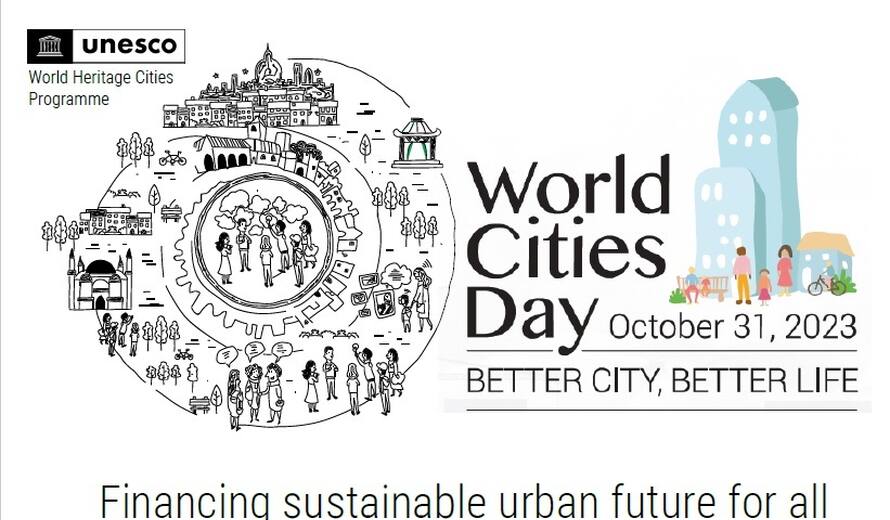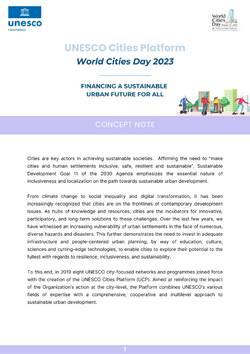“Financing Sustainable Urban Future for All”: the World Heritage Cities Programme celebrates World Cities Day 2023 through “Ensuring Inclusive Economic Benefits of Urban Heritage”
The 2011 Recommendation on the Historic Urban Landscape (HUL Recommendation) is a perfect herald for the theme of the 2023 World Cities Day, “Financing sustainable urban future for all”. The HUL Recommendation is a crucial instrument for managing urban heritage in and around settlements and cities to recognize, protect and integrate historic built environments into urban planning for sustainable development and people-centred places. The HUL Recommendation enhances synergies with the 1972 World Heritage Convention, the New Urban Agenda and the 2030 Agenda for Sustainable Development.
In line with the HUL Recommendation, the World Heritage Cities Programme, as the Secretariat, has worked with the UNESCO Member States to establish a global network of focal points at the national and city levels for the implementation of the HUL Recommendation. This network came together to share the key results concerning “Ensuring Inclusive Economic Benefits of Urban Heritage” of the Third Consultation on the Implementation of the 2011 Recommendation on the Historic Urban Landscape. Out of the 193 Member States, 187 reports were received from 69 Member States, with 62 national reports and 125 local reports.
The HUL Recommendation recognizes the need for financial sustainability of conservation efforts in historic urban areas, including for the many privately owned historic buildings. It encourages innovative financial models and instruments to enable the conservation of even ordinary housing in historic urban areas, recognizing the need to protect heritage with local value and meaning. The HUL Recommendation also emphasizes the potential of historic urban areas to promote sustainable livelihoods, including for women, indigenous peoples and vulnerable groups. These activities should be compatible with the conservation of attributes of urban heritage of historic urban areas. The HUL Recommendation emphasizes the importance of innovative financial tools that support traditional income-generating activities for local communities enabling inclusive economic development.
The Third member States Consultation revealed that:
- Responding Member States reported a variety of measures to support conservation and sustainable development, while gauging systemic challenges. About half the responding Member States have financial policies, instruments and modalities to encourage, support heritage conservation, and have financial incentives for the conservation of privately owned historic buildings. About 20% of the responding Member States have policies to ensure the continuity of local communities in regeneration strategies, revealing a need for economic responses from respective national governments.
- However, less than 40% of the responding local governments advance policies such as microcredit and loans to support small businesses, traditional occupations and artisanal practitioners, and a very low proportion of cities report financial tools and policies to mitigate the negative effects of gentrification indicating the need for equity and inclusion in the availability of financial mechanisms. Overall, the reports indicate a pressing need for greater policy coherence and coordination to develop innovative financial strategies for urban heritage management.
- The 2011 Recommendation emphasizes the need for financial sustainability and inclusion in the conservation of public and private historic buildings, as well as the importance of flexible financing mechanisms such as micro-credit to support local enterprise and various partnership models. However, national-level responses indicate that only about half of responding Member States have financial policies, instruments and modalities in place to support local economies and promote heritage conservation.
- Less than half of the reporting cities have policies or programmes to promote micro, small and medium-sized cultural enterprises in historic urban areas. Nationally led financial incentives for the conservation of privately owned historic buildings are prevalent in half of the responding Member States, making the protection of historic buildings and areas of public interest a challenge. For instance, the local municipality of Kasama city in Zambia provides loans at very low interest rates through national government funding, through the Constituency Development Fund.
Ways forward that emerge from the the Third Member State Consultation on the implementation of the HUL Recommendation include:
- Urban heritage conservation processes such as adaptive reuse of historic housing fabric and public open spaces could advance equity and access to housing.
- Urban heritage conservation processes integrating social housing by adapting historic buildings and neighbourhoods for affordable and diverse housing could help address social needs in historic urban areas.
- Advancing financial policies and measures to support local economic development in historic urban areas to promote micro, small, and medium-sized enterprises promoting compatible and sustainable livelihoods and sustainable tourism policies.
- Putting in place policies and processes for compatible adaptive reuse of historic built fabric, ensuring financial tools and measures for the continuity of local communities.
- Ensuring policy coherence and coordination between national and local financial policies and measures to support innovative strategies for financing urban heritage conservation and sustainable development at the local level.
For the consolidated summary of the Third UNESCO Member States Consultation on the Implementation of the 2011 Recommendation on the Historic Urban Landscape, please visit: https://whc.unesco.org/en/news/2528/
The World Heritage Canopy platform gathers good practices and practical resources for World Heritage site managers and the national and local focal points s for integrating the conservation of urban heritage with sustainable development actions. They provide local solutions furthering heritage conservation as well as advancing sustainable development and resilience for World Heritage properties. Some case studies for local economic development and innovative financial solutions for managing urban heritage include:
- Reintroduction of hydropower in the mills district of the Town of Bamberg (Germany) (Europe and North America).
- Cash for work: promoting local employment through heritage conservation in historic cities (Yemen) (Arab States)
- Promoting local development through heritage conservation and enhancement and tourism on the island of Saint-Louis (Senegal) (Africa).
- Conservation and revitalisation programme of Ancient City of Ping Yao (China) (Asia and the Pacific)
- Update of the Management Plan of the Historic Monuments Zone of Querétaro (Mexico) (Latin America and the Caribbean).
On 16 November 2023, the full consolidated results of the Survey will be presented to the UNESCO 42nd General Conference and will be published online. For more information on UNESCO’s celebration of World Cities Day 2023, please visit World Cities Day 2023.
Message from Ms Audrey Azoulay, Director-General of UNESCO on World Cities Day 2023



